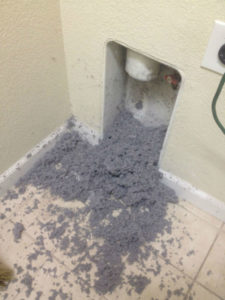When was the last time you had your clothing dryer vents cleaned and inspected? If you can’t remember, or if the answer is never, you need to evaluate your dryer’s operation to determine if your vents are clogged with lint and in need of cleaning.
 When dryer vents become clogged with arrant lint, the vents can overheat and the lint can ignite and cause a major home fire. In fact, dryer vents cause an estimated 15,000 home fires each year, the majority of which could have been prevented with regular dryer vent cleaning. Clothing dryer vents should be cleaned at least once per year, according to the National Fire Protection Association, to lower your home’s risk of a dryer-sparked fire. Vents might need to be cleaned even more frequently if you do a lot of laundry.
When dryer vents become clogged with arrant lint, the vents can overheat and the lint can ignite and cause a major home fire. In fact, dryer vents cause an estimated 15,000 home fires each year, the majority of which could have been prevented with regular dryer vent cleaning. Clothing dryer vents should be cleaned at least once per year, according to the National Fire Protection Association, to lower your home’s risk of a dryer-sparked fire. Vents might need to be cleaned even more frequently if you do a lot of laundry.
If you are skeptical about the need to clean your dryer vents, your dryer could be sending you signs that its vents are clogged and close to overheating.
Those signs include:
- Longer than normal dryer times. If your dryer can’t vent or combust properly do to clogged vents, the time it take you to dry your clothing or linens will increase. An average load of clothing should not take more than 30 to 40 minutes to dry.
- Clothes that are hot to the touch. If heat can’t escape the dryer, that heat will stay within the dryer’s drum. If your clothes seem unusually hot when you take them out of the dryer, that is a sign that your vent is at least partially blocked.
- An overheated laundry room. Similarly, if heat can’t escape the dryer, it can lead to overheating in your laundry room. If your laundry room seems overly warm when your dryer is running, it is time to have your dryer vents cleaned.
- A musty or burning smell, or a strong smell of dryer sheets. Clogged dryer vents can cause a few odd smells in your laundry or in your laundry room. If your clothing or your laundry room inexplicably has a musty smell or a burning smell, or smells strongly of dryer sheets, your dryer vents should be checked.
- A buildup of lint in the lint trap or around the external dryer vent. If lint can’t exit your dryer into the vents, it doesn’t have anywhere to go, so it will back up into your dryer and into your dryer’s lint trap. Similarly, dryer lint may blow out of the dryer exhaust outside your home.
- A dryer vent flap that doesn’t open or close when the dryer is running. When your dryer is “breathing” properly, the flap on the exterior of your home should open and close as the dryer exhausts its heat. If the flap is immobile, it is a sign that the vent is blocked.
If your dryer is showing any of the signs of clogged dryer vents, call Total Chimney Care today! We will clean and inspect your dryer vents to keep your dryer operating safely and reduce your risk of a dangerous dryer fire.
